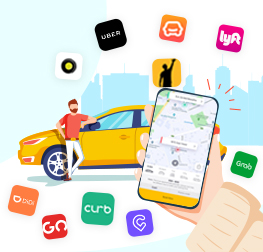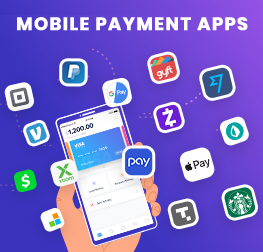5 Service Industries that are Propelling the On-demand Economy (Why should you develop On-demand Apps?)
The On-demand economy is shifting the face of traditional business models faster than ever. On-demand apps are transforming the way businesses used to serve their customers.
The concept of “Uber for X” has not only fostered many business models but also opened up opportunities for mobile app development companies.
Ever since Uber disrupted the market by launching one of the first on-demand apps of its kind, it influenced to bring similar concepts in other industries as well.
Some of the popular apps that are driving the on-demand economy are Postmates (on-demand food delivery app), Drizly (on-demand alcohol delivery app), Handy (on-demand moving app), Lyft (on-demand cab booking app), InstaCart (on-demand grocery delivery app), and many more.
According to a survey by Burson-Marsteller, the Aspen Institute, and Time, around 42% or 86.5 million Americans have used at least one of the on-demand services.
Not only that, one of the primary reasons why on-demand apps are driving the economy is that it provides jobs to 22% or 45.3 million Americans.
This is the profound reason for VCs and Angel investors to invest in any startup that has the “on-demand” word attached to its business model.
Industries Disrupted by the On-demand Economy
According to RockBridge, Consumers in the US spent around $75.7 billion in 2017 compared to $48 billion in 2016. The sheer growth of 58% shows us how big the on-demand economy is going to get in the upcoming years.
The growth on-demand services have inspired enterprises and startups across the globe to automate their services and increase their availability for consumers.
#1 Travel
Thanks to Uber, travel is the sector that is affected the most from the on-demand economy after the online market place.
Apart from this, the top 5 on-demand startups in the world have received more than 75% of the total funding, among which four startups belong to the travel and transportation industry.
If we look at the sheer size of success that Airbnb and Uber have received, they should be seen as an inspiration for the new startups rather than the competition.
The example of Didi, a cab booking app in China, tells us that nothing is impossible. It beat Uber in its own game and became the #1 cab booking app in China.
This is not the first time that Uber faced a setback. In India, Ola is giving a tough competition to Uber by providing similar yet one of a kind taxi on-demand taxi booking services.
#2 Food Delivery
On-demand food delivery apps have made their way through the on-demand economy. Food delivery has been half baked business until today.
People used to order food by calling the restaurant or food chain. It sometimes led to confusion regarding a delivery address, ordered items, quantity, etc.
But, with food delivery apps, that problem is solved since restaurants receive the orders in perfect order with precise written information regarding delivering an address and food items.
Today, people are using on-demand food delivery apps for their breakfast, lunch, dinner, and even for snacks. According to Statista, online food delivery business revenue in the USA reached $22,073 million in 2019 and is predicted to grow at a CAGR of 6.5% this year and reach up to $28,398 million in 2023 in revenue.
On-demand food delivery apps have become a boon for restaurants who didn’t offer home delivery. These food delivery players charge from both restaurants and their customers.
The market has already matured in countries like the US, UK, India. In contrast, it is still growing in countries like Saudi Arabia, South Korea, and Brazil.
#3 Healthcare
Healthcare is one such industry, which is in desperate need of on-demand services. Currently, patients are spending hours in line for their turn to come.
Moreover, there are only a few pharmacies in a certain city that is open 24/7. Therefore in case of an emergency, patients have to face many troubles.
On-demand services have changed the face of the healthcare industry. Now, patients can order medicines sitting at their homes at any time on their fingertips.
The app not only allows you to order medicines at your doorstep but also allows you to book appointments with your doctor and receive the medical reports as well.
Possibilities with On-demand Health Care Services:
- Call a doctor at home (e.g., Doctor on Demand)
- Talk to any doctor across the country or world (e.g., Healthtap)
- Order medicine 24/7 (e.g., Pillpack)
#4 Field Services and Professional Services
Field and professional services are the sectors that underwent a massive transformation with the arrival of the on-demand economy. It was also one of the most rigid industries to enter into the on-demand economy.
After healthcare, this is another sector that was in a desperate need to enter the on-demand economy. Field and professional services have maximum potential since it covers all the professional services like machine repair, carpentry, pest control, electrician, babysitting, plumbing, household work, and more.
No app provides all the services under one roof. Different apps offer different services to customers. For example…
- NuevaCare (On-demand home care services provider for elders)
- Handy and Serviz (On-demand field services to contact electrician, plumber, and more)
#5 Transportation and Logistics
Transportation and logistics is a sensitive business. However, similar to other verticals, it also underwent a massive shift after entering the on-demand economy.
Today, because of on-demand moving apps like Postmates, Deliv, GetWagon, etc. logistics services has become efficient and smooth than ever.
On-demand apps have helped small players/independent movers and packers to expand their outreach to more customers. Mobile apps also helped to increase customer experience.
Earlier, transportation companies offered SMS based courier tracking. Now they’ve upgraded to a mobile app through which customers can track the courier in real-time via integrated maps.
Apart from these benefits, on-demand apps also regulated the messy price structure of the various transportation companies and individual transporters.
Conclusion
The industry or sectors mentioned above are the top 5 sectors affected by the on-demand economy. Apart from these, almost every industry is disrupted by on-demand services.
With technological advancements, the competition among various firms will increase. The firms that will not adapt to this change will be thrown away from the competition.
On-demand apps are going to be the future of every traditional industry. If you have a business idea in mind, try to mold it in a way that lets you thrive in the on-demand economy.
If you don’t know how to do it, come to us, and we’ll guide you to develop world-class on-demand apps that’ll help you to sustain in the fierce competition.
FAQs
1) How much does it cost to build an on-demand app?
The cost of an on-demand app depends on your service industry and requirements. Roughly, it takes around $90,000 to build an on-demand services app. The cost can range from $10,000 to $500,000.
2) How much does it cost to build an app like Uber?
To develop an app like Uber from scratch, it would take around $30,000 to $35,000 at an hourly rate of $50. However, if you wish to develop for both Android and iOS platforms, it would cost you $65,000 roughly.
3) Which platform to choose for on-demand app development?
While choosing the platform, demographics, and geography matters the most. However, if you’re targeting the global audience and have a tight budget, then you should go with Android since there are more Android users than iOS.
4) How much does it cost to build an app like Airbnb?
The average cost to build an app for the iOS platform would start from $40,000, whereas to build the clone for Android would at least cost you $50,000.











Tags: